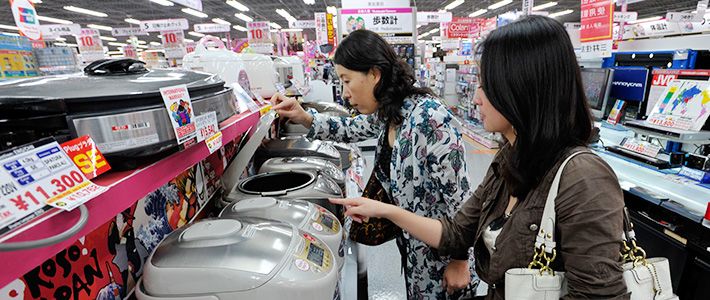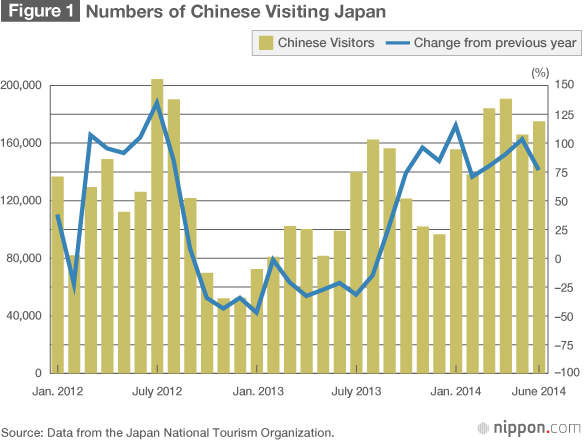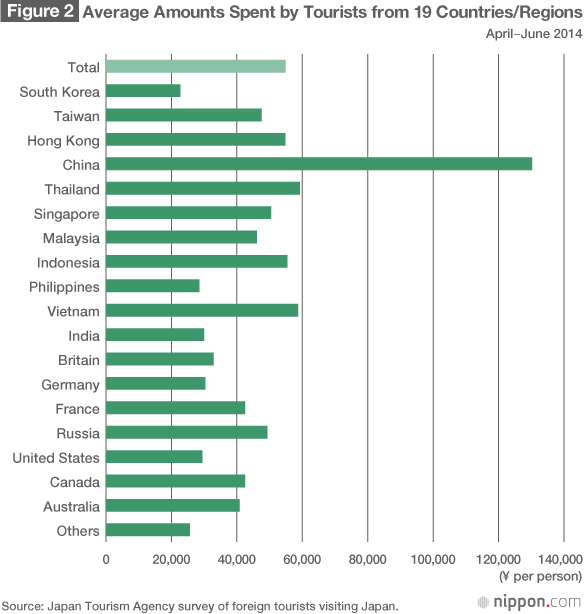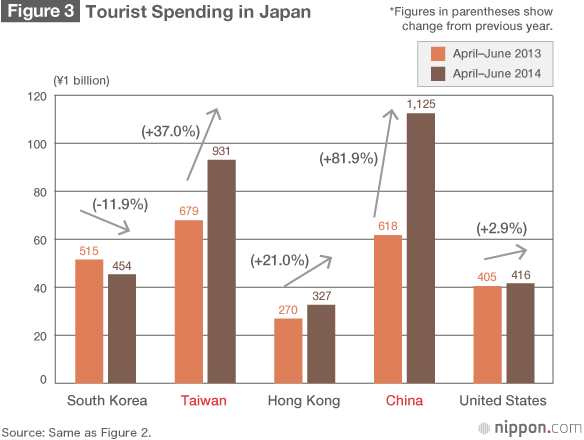
Chinese Tourists in Japan: Return of the Big Spenders
Economy Society Culture- English
- 日本語
- 简体字
- 繁體字
- Français
- Español
- العربية
- Русский
Recovery from a Sharp Drop
The number of Chinese visitors to Japan dropped dramatically after the government of Prime Minister Abe Shinzō nationalized the Senkaku Islands on September 11, 2012. The islets, located in the East China Sea, are claimed by both Japan and China and have become a major point of contention between the two nations. The move by Japan inflamed anti-Japanese sentiment in China, sparking large-scale demonstrations and serving to deter Chinese from visiting their neighbor to the east.
According to figures from the Japan National Tourism Organization, October 2012 saw the number of tourists from China plummet by nearly half, shrinking to 69,713 from 121,673 the previous month. Overall figures for 2012 fell by 34.3% from the previous year, with the minus trend extending into 2013 and continuing a total of 11 months. It was not until September 2013, nearly a year after the tumult over the Senkakus began, that active anti-Japanese sentiment in China cooled to a point where tourists began returning. A 28.4% year-on-year increase posted that month marked the beginning of a sustained upward swing, with January–June 2014 seeing the arrival of over 1 million Chinese visitors, an upsurge of 88.2% from the same period of the previous year. At this rate the total for 2014 will be a record high.

Chinese have not only been returning in droves, but have been loosening their purse strings in an enthusiastic display of consumer spending. A Japan Tourism Agency survey of 6,600 visitors to Japan taken during the second quarter of 2014 showed Chinese leading all other nationals in travel spending, laying out an average of ¥211,784 per person for their trips, compared with an overall figure of ¥143,942. April–June 2014 saw 531,258 Chinese travel to Japan, an 89.2% increase from the same period of the previous year, and spend ¥112.5 billion, accounting for 23.1% of all tourist spending during the period. By comparison, tourists from Taiwan spent ¥93.1 billion, South Korea ¥45.4 billion, the United States ¥41.6 billion, and Hong Kong ¥32.7 billion.
Top-Spending Tourists
Among the 19 countries and regions sampled under the JTA survey, tourists from China were the most unrestrained shoppers, dropping ¥130,293 per person, against an overall average of ¥54,900. Visitors from Thailand were the second-biggest spenders at ¥59,279 per person, followed by those from Vietnam at ¥58,726. Shoppers from Western countries tended to be more frugal, staying well below the ¥50,000 mark, with Americans averaging just ¥29,425 per trip.
Many Chinese travelers are including shopping sprees at the numerous electronics stores in Akihabara and other districts around Tokyo as part of their itineraries. On average, Chinese tourists shell out a total of over ¥80,000 per person on cameras, camcorders, and watches, and they spend more than ¥50,000 on other electronic items. Their average outlays for other high-end items, such as clothing, handbags, cosmetics, and consumer healthcare products, range from around ¥25,000 to over ¥50,000. In comparison, American tourists usually spend less than ¥20,000 on similar items.

The Attraction of the “Made in Japan” Brand
In response to the increase in customers from China, major electronics stores in Tokyo have hired Chinese-speaking staff, and it is common to hear the sales floors alive with the buzz of Mandarin. At the main Akihabara branch of the Laox chain, an affiliate of the Chinese electronics retail giant Suning Appliance, 70% of the customers are said to be from China. And this phenomenon is not unique to Akihabara. An employee at Bic Camera, a chain with stores in Ikebukuro, Shinjuku, and other major shopping districts around the capital, notes that as Chinese shoppers have increased, high-end products, in particular professional-grade cameras and deluxe rice cookers, have been “selling like hotcakes.”
Why do Chinese visitors choose to buy these products in Japan despite the availability of similar items at home? As one Chinese individual explains, “It’s because they want items that are made in Japan.” He adds, “There have actually been cases where people buy what they assume are Japanese products as presents for people at home but, when the recipients open them up, they’re disappointed to find them marked ‘Made in China,’ This would be funny if it weren’t so unfortunate. The highest-quality cameras and lenses are made in Japan, and people are willing to pay hundreds of thousands of yen for the items they want.”

Stops at ¥100 Shops
Chinese shoppers, attracted by the high quality of Japanese products and by the virtual absence of counterfeits, are thronging the luxury-brand shops of Tokyo’s tony Ginza district. But they are not all just going to the high-end shops in the center of the capital; recently they have also begun to show up at the large outlet malls in the suburbs. They have even become enamored of Japan’s ubiquitous ¥100 shops, where the uniform price is slightly less than $1 per item, and a growing number of sightseeing tours are featuring stops at hyakkin, as the shops are popularly called in Japanese. Similar shops have been springing up in China as well, selling goods at the uniform low price of 10 yuan (about ¥170). But Chinese tourists say the quality of the goods at Japan’s hyakkin is much higher than at the 10-yuan shops at home.
The key to successful business is reliability. This is something we must not forget.
(Chinese tourists look at electric rice cookers, which are among the made-in-Japan products that many of them seek out. Photo © Jiji Press)
China Chinese tourists home electronics rice cookers made in Japan 100 yen shop foreign tourists tourist spending